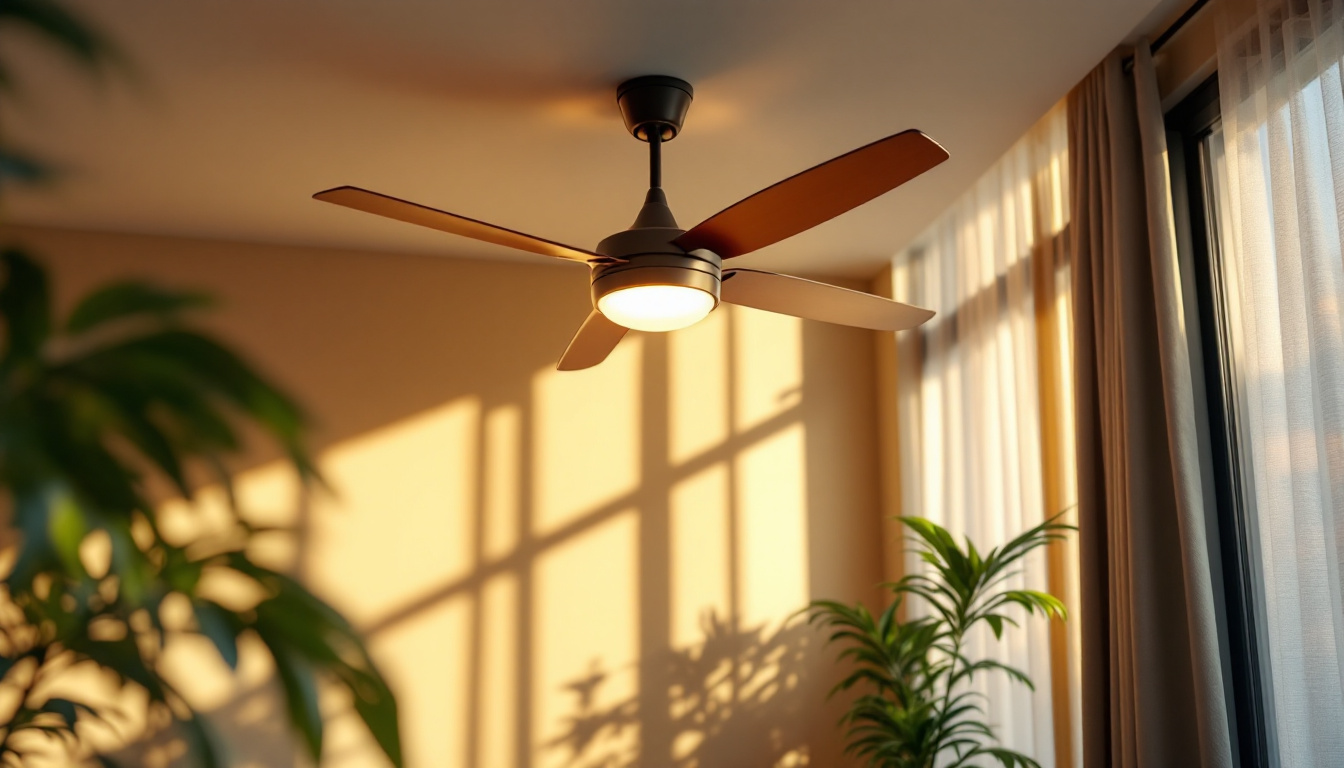
In the competitive world of lighting contracting, having a comprehensive understanding of ceiling fan components can significantly enhance service offerings. Ceiling fans are not just functional devices; they are also design elements that can elevate the aesthetic appeal of a space. For lighting contractors, knowledge of ceiling fan parts can provide a competitive edge, allowing them to offer tailored solutions to clients while ensuring high-quality installations and repairs.
Ceiling fans consist of several key components that work together to provide efficient air circulation and lighting. Understanding these parts is essential for any lighting contractor looking to expand their expertise and service offerings.
The motor is the heart of a ceiling fan, responsible for driving the blades and generating airflow. Ceiling fan motors come in various types, including AC and DC motors, each with its advantages. AC motors are typically more common and cost-effective, while DC motors are quieter, more energy-efficient, and often come with additional features like remote control capabilities.
The blades, usually made from wood, plastic, or metal, play a crucial role in determining the fan’s efficiency and aesthetics. The pitch of the blades can significantly affect airflow, making it essential for contractors to understand how blade design impacts performance. A well-designed fan with the right blade pitch can effectively circulate air, enhancing comfort in residential and commercial spaces.
Many ceiling fans come equipped with light kits, which can add functionality and ambiance to a room. Lighting contractors should be familiar with the various types of light kits available, including integrated LED lights, incandescent bulbs, and compact fluorescent options. Each type has its benefits and drawbacks, impacting energy consumption, brightness, and warmth of light.
Moreover, understanding how to install and replace these light kits is crucial. A well-installed light kit not only enhances the fan’s functionality but also ensures safety and compliance with local electrical codes. This knowledge can set a contractor apart from competitors who may not offer comprehensive ceiling fan services.
Proper installation is key to ensuring ceiling fans operate efficiently and safely. Lighting contractors must be well-versed in the installation process, including the necessary tools and techniques.
Ceiling fans can be mounted in various ways, including flush mount, downrod mount, and angled mount. Each mounting option serves a specific purpose and is suitable for different ceiling heights and designs. For instance, flush mounts are ideal for low ceilings, while downrod mounts are better for high ceilings, allowing for optimal airflow.
Understanding the different mounting options enables contractors to recommend the best solution for their clients’ specific needs. This knowledge not only enhances customer satisfaction but also reduces the likelihood of installation issues down the line.
Electrical safety is paramount when installing ceiling fans. Contractors must ensure that the electrical box is rated for fan support and that all wiring is done according to local codes. Understanding the electrical requirements for ceiling fans, including voltage and amperage, is crucial for preventing potential hazards.
Additionally, offering clients advice on smart ceiling fan options can further enhance service offerings. Many modern ceiling fans come with smart technology that allows users to control them via smartphone apps or voice commands. Familiarity with these systems can set a contractor apart in a crowded marketplace.
Regular maintenance is essential for ensuring the longevity and efficiency of ceiling fans. Lighting contractors can provide valuable services by educating clients on how to care for their fans and troubleshoot common issues.
Regular cleaning and maintenance can prevent dust buildup and ensure optimal performance. Contractors should advise clients on how to clean fan blades and check for loose screws or connections. Additionally, lubricating the motor and checking the pull chain for wear can extend the fan’s lifespan.
By offering maintenance packages or reminders for seasonal check-ups, contractors can build long-term relationships with clients, ensuring repeat business and referrals.
Lighting contractors should also be prepared to troubleshoot common ceiling fan issues, such as wobbling, noise, or failure to operate. Understanding the root causes of these problems can help contractors provide quick and effective solutions.
For instance, a wobbling fan may be due to unbalanced blades or loose mounting hardware. By diagnosing the issue and providing solutions, contractors can enhance their reputation as knowledgeable and reliable professionals.
Ceiling fans are not just functional; they also play a significant role in the overall design of a space. Lighting contractors should be aware of the aesthetic aspects of ceiling fans to better serve their clients.
Ceiling fans come in various styles and finishes, from modern to traditional designs. Understanding the different options available allows contractors to recommend fans that complement the existing decor of a room. Whether a client prefers a sleek, contemporary fan or a classic wooden design, having a variety of options can enhance the contractor’s appeal.
Additionally, the finish of the fan can impact the overall ambiance of a space. For example, a brushed nickel finish may lend a modern touch, while an oil-rubbed bronze finish can add warmth and character to a traditional setting. Being knowledgeable about these design elements can help contractors position themselves as experts in the field.
The color and size of a ceiling fan are also critical factors to consider. A fan that is too small for a large room will struggle to provide adequate airflow, while an oversized fan can overwhelm a small space. Contractors should be prepared to measure rooms and recommend appropriate fan sizes based on square footage and ceiling height.
Moreover, color can influence a room’s mood and energy. For instance, lighter colors can create a sense of openness, while darker colors may add coziness. By discussing these aspects with clients, contractors can help them make informed decisions that enhance their living or working environments.
As energy efficiency becomes increasingly important to consumers, lighting contractors must be knowledgeable about the energy-saving features of ceiling fans. This knowledge can help contractors market their services effectively and appeal to environmentally conscious clients.
Many ceiling fans now come with Energy Star ratings, indicating that they meet strict energy efficiency guidelines set by the Environmental Protection Agency. Contractors should be familiar with these ratings and be able to explain their significance to clients. By promoting Energy Star-rated fans, contractors can help clients reduce their energy bills while contributing to a more sustainable environment.
Additionally, educating clients about the benefits of using ceiling fans in conjunction with their HVAC systems can lead to further energy savings. For instance, using a ceiling fan can allow homeowners to raise their thermostat settings in the summer, reducing air conditioning costs.
Smart ceiling fans are becoming increasingly popular, offering features such as remote control, scheduling, and integration with smart home systems. Lighting contractors should stay informed about the latest advancements in smart ceiling fan technology to provide clients with cutting-edge solutions.
By offering smart ceiling fans, contractors can help clients enhance their comfort and convenience while also promoting energy efficiency. This knowledge positions contractors as forward-thinking professionals who are attuned to the latest trends in home technology.
With a solid understanding of ceiling fan components, installation, maintenance, and design, lighting contractors can effectively market their expertise to attract new clients. A well-crafted marketing strategy can highlight the unique services offered and establish a contractor’s reputation in the industry.
In today’s digital age, having a strong online presence is essential for any business. Lighting contractors should consider creating a website that showcases their expertise in ceiling fans, including installation, maintenance, and design advice. Including high-quality images and detailed descriptions of services can help attract potential clients.
Social media platforms can also be valuable tools for marketing. Sharing tips, showcasing completed projects, and engaging with clients can help build a loyal following and generate referrals. By actively participating in online communities related to home improvement and design, contractors can position themselves as trusted experts in the field.
Building relationships with other professionals in the home improvement industry can lead to valuable referrals and partnerships. Lighting contractors should consider networking with electricians, interior designers, and real estate agents who may recommend their services to clients. Collaborating on projects or co-hosting workshops can also enhance visibility and credibility.
By establishing a network of trusted professionals, contractors can create a referral system that benefits all parties involved. This collaborative approach can lead to increased business opportunities and a stronger reputation in the community.
In the ever-evolving landscape of lighting contracting, understanding ceiling fan parts and their applications can provide a significant competitive edge. From installation and maintenance to design and energy efficiency, contractors who invest in their knowledge and skills will be better positioned to meet the diverse needs of their clients.
By staying informed about the latest trends and technologies in ceiling fans, lighting contractors can enhance their service offerings and build lasting relationships with clients. Whether through effective marketing strategies or networking with industry professionals, the potential for growth and success in the ceiling fan market is vast. Embracing this knowledge will not only elevate a contractor’s business but also contribute to the overall satisfaction and comfort of clients.
Ready to give your lighting contracting business the competitive edge with high-quality ceiling fan parts? Look no further than LumenWholesale. Our extensive selection of spec-grade lighting products is designed to meet the highest industry standards, ensuring you deliver reliable and high-performance solutions to your clients. With unbeatable wholesale prices and the convenience of free shipping on bulk orders, you can trust LumenWholesale to provide the best value without any hidden fees. Elevate your service offerings and delight your clients with the perfect blend of quality, affordability, and convenience. Wholesale Lighting at the Best Value is just a click away.

Discover how bypassing a ballast can revolutionize your lighting projects and enhance your business efficiency.

Discover the frequent pitfalls lighting contractors face with light switch receptacles.

Discover how lighting contractors can enhance efficiency and reduce costs with innovative hallway lighting solutions.

Discover the perfect blend of style and functionality with our guide to ceiling fans on sale.